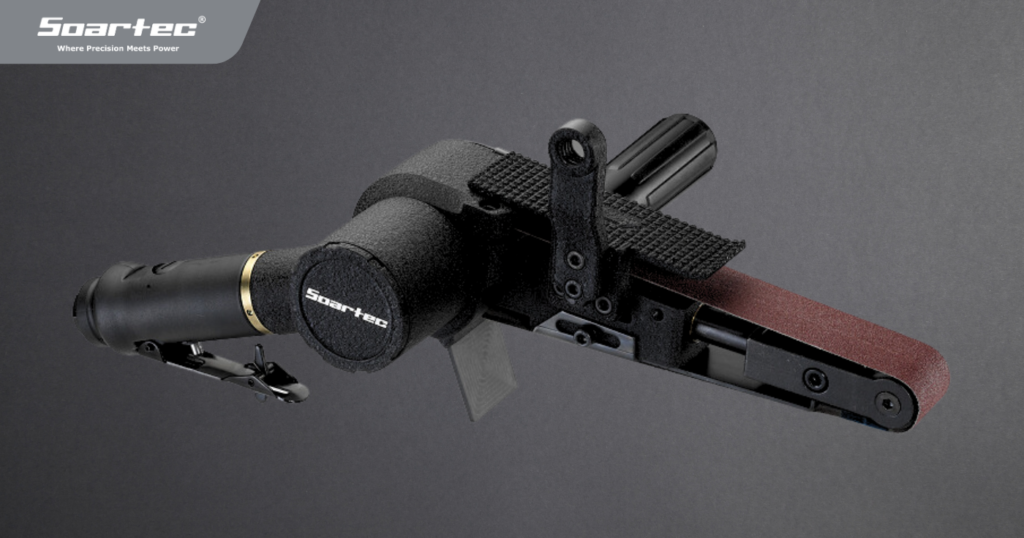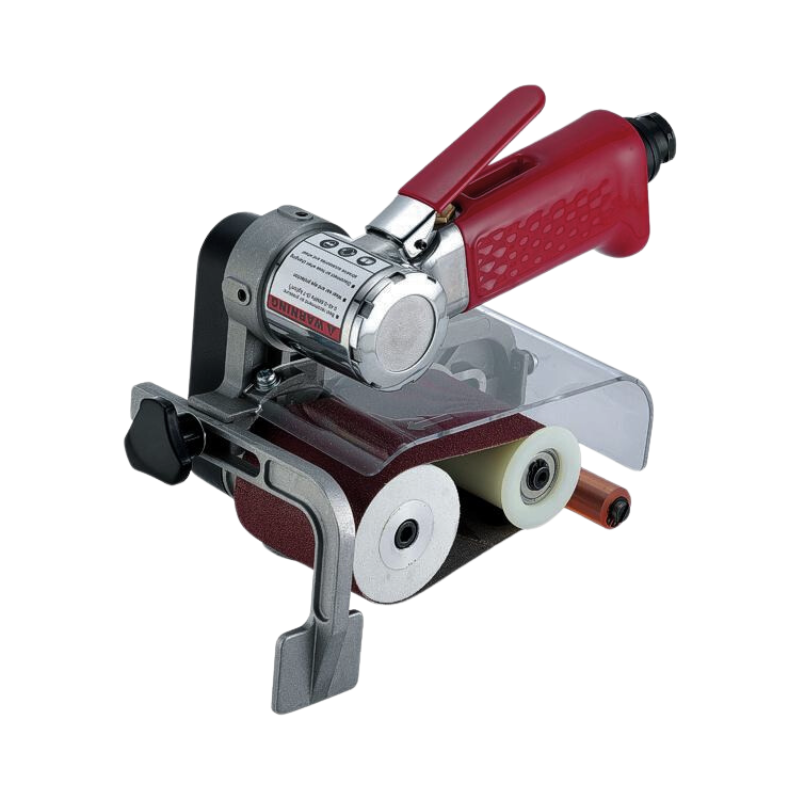
In the realm of home improvement and craftsmanship, selecting the right tools significantly impacts efficiency and outcome. The air belt sander emerges as an exemplary choice for hobbyists and professionals alike, merging power with precision to handle a multitude of tasks. Known for its versatility, the air belt sander, an advancement on the traditional industrial sander, is engineered to offer unparalleled surface finishing capabilities. With features such as adjustable belt size, optimized air inlet, and ergonomic handle angle, this pneumatic belt sander caters to a broad range of sanding applications, from the removal of paint and rust to the smoothing of wood surfaces.
Delving into the specifics, this article will explore the key features distinguishing air belt sanders from their counterparts, highlighting how factors like hose size and air consumption contribute to their utility and performance in home projects. Ease of use and handling is a focal point, ensuring users can achieve professional-grade results without the steep learning curve often associated with industrial equipment. Moreover, the comparative advantages over electric sanders, such as superior maneuverability and less dependency on electrical outlets, underscore the air belt sander’s suitability for diverse environments. By illuminating how these aspects enhance home projects, readers will gain a holistic understanding of why an air belt sander stands out as the perfect tool for their next endeavor.
Key Features of Air Belt Sanders
Variable Speed Control
Air belt sanders offer variable speed controls, allowing users to adjust the speed according to the task at hand. This feature is crucial for preventing damage when working with delicate materials or when performing finish work, as it provides better control over the sanding process. Users can operate the sander at lower speeds for fine grits, enhancing precision and the quality of the finish.
Different Belt Sizes
The versatility of air belt sanders is further enhanced by the availability of different belt sizes. This allows for optimal adaptation to various project scales, from detailed work requiring smaller belts to larger tasks that benefit from wider belts. Understanding how to measure and select the correct belt size is essential, ensuring efficient performance and desired results across diverse applications.
Dust Collection Systems
Effective dust management is integral to maintaining a clean and safe work environment when using air belt sanders. Many models come equipped with integrated dust extraction systems or the capability to connect to external vacuum systems. These systems capture airborne particles during operation, significantly reducing cleanup time and enhancing visibility, which is particularly beneficial in confined or indoor spaces.
Ease of Use and Handling
Ergonomic Designs
Air belt sanders, particularly models like the Dynafile II, are designed with ergonomics in mind. The evolved design minimizes user fatigue and enhances control, especially in tight spaces where traditional sanders might not fit. This ergonomic focus ensures that users can operate the tool for extended periods without discomfort, making it ideal for both quick tasks and longer, more demanding projects.
Lightweight and Portable
The portability of air belt sanders is a significant advantage. These tools are lightweight, making them easy to maneuver and transport. Whether moving between different workstations or adjusting positions within a project, the user can handle the sander with ease, which is crucial for maintaining precision in detailed work.
Adjustable Settings
Flexibility is key in handling diverse project requirements, and air belt sanders excel in this area with their adjustable settings. Users can modify the speed and belt size according to the specific needs of the material and task at hand. This adaptability not only boosts the tool’s utility but also enhances the overall quality of the finish, providing a tailor-made solution for each unique project.
Advantages Over Electric Sanders
Air belt sanders offer several distinct advantages over electric sanders, particularly in terms of operational efficiency and maintenance requirements.
No Overheating
Unlike electric sanders, air belt sanders are less prone to overheating. This is due to their pneumatic nature, which does not rely on electrical components that generate heat during operation. Consequently, they can be used continuously in various temperature conditions without the risk of shutdown due to excessive heat, ensuring uninterrupted work and greater comfort for the user.
Durability and Longevity
Constructed with robust materials like aluminum and designed for demanding environments, pneumatic sanders exhibit enhanced durability. Their ability to withstand greater workloads and less mechanical stress contributes to a longer lifespan compared to electric sanders. This durability makes them a more cost-effective choice in the long run, especially in production settings where longevity is crucial.
Lower Maintenance
Maintenance for air belt sanders is generally straightforward, primarily involving regular oiling and air filter upkeep. These tasks are less cumbersome compared to the internal maintenance often required for electric sanders, which can include motor and brush checks. Additionally, the simple construction of air belt sanders minimizes the frequency of repairs, reducing the overall maintenance burden and associated costs.
Enhancing Home Projects with Air Belt Sanders
Achieving Professional-Quality Finishes
Air belt sanders are renowned for their ability to produce exceptionally smooth finishes, surpassing traditional electric sanders. The consistent, powerful sanding motion provided by compressed air allows for efficient material removal, achieving a finer finish without the swirl marks often left by electric models. This makes air sanders particularly valuable for projects requiring a high-quality aesthetic, such as furniture refinishing or detailed woodworking.
Speeding Up Project Timelines
One of the primary advantages of using an air belt sander in home projects is the significant reduction in time required for sanding. Professionals in woodworking and metalworking have noted that these tools are indispensable for quickly progressing through tasks that would otherwise consume considerable effort and time. Whether flattening panels, shaping table legs, or preparing surfaces for painting, the air belt sander drives productivity, enabling DIY enthusiasts to complete projects faster and with less physical strain.
Expanding Your DIY Capabilities
The versatility of air belt sanders extends beyond just basic sanding; they are equipped to handle a variety of pads and grits, accommodating different finishes based on project needs. This adaptability allows users to undertake a broader range of DIY tasks, from auto bodywork to intricate furniture detailing. Additionally, the lightweight and compact design of these sanders makes them ideal for use in various settings, enhancing the user’s ability to tackle diverse home improvement projects with precision and ease.
Conclusion
Throughout this exploration of air belt sanders, we’ve underscored their considerable advantages for home projects, emphasizing their unique blend of power, precision, and versatility. These tools not only surpass traditional electric sanders in maneuverability and ease of use but also in the level of finish they deliver, making them an ideal choice for both novices and seasoned craftsmen. Whether it’s woodworking, metalworking, refinishing furniture, or tackling intricate detailing, air belt sanders equip users with professional-grade capability, enhancing project outcomes and expanding the scope of DIY possibilities.
In sum, the adoption of air belt sanders represents a smart move towards achieving finer finishes, speeding up project timelines, and elevating the overall quality of home improvement tasks. Given their operational efficiency, durability, and the ability to produce superior results with minimal effort, these tools are a worthy investment for anyone looking to enhance their craftsmanship. As we look towards future endeavors that require detailed finishing and precision, considering an air belt sander’s role in our toolkit becomes not just beneficial but essential.
Ready to purchase? Click here.
FAQs
What are the benefits of using a pneumatic sander?
Pneumatic sanders are particularly beneficial in industrial sanding due to their durability and ability to handle heavy workloads. Their compact and lightweight design ensures smooth and precise handling, which is crucial for achieving perfect sanding results.
What tasks is a belt sander most effective for?
Belt sanders are highly efficient at removing large amounts of material quickly. They are especially useful for leveling uneven surfaces, removing old paint or varnish, and smoothing rough wood.
What are some potential drawbacks of using a belt sander?
While belt sanders are excellent for quick material removal, their aggressive nature can also be a drawback. If not handled with care, they can remove too much material or leave gouges in the wood. Additionally, due to their aggressiveness, they may not provide as fine a finish as other types of sanders, like drum sanders.
Which type of sander is recommended for achieving the best finish and why?
A Random Orbital Sander is highly recommended for achieving the best finish. It operates similarly to an orbital sander but features an off-set rotation of the base. This unique movement causes each grain of sand to move in a small spiral pattern, resulting in a smoother, streak-free surface.



